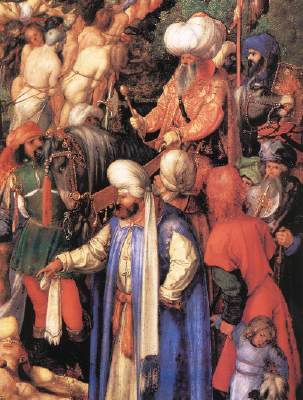This picture fascinated me. It is a very disturbing work of art. It was full of everything going on and one could spend ages looking at all the details of the scene. I love this type of painting. I love discovering new things every time I gaze at it. I am starting to think that maybe instead of looking at Old Masters I should concentrate on “Where’s Waldo” pictures – only kidding !
The painting in My Daily Art Display is entitled The Martyrdom of Ten Thousand by Albrecht Dürer, which he painted in 1508 and it can now be found in the Kunsthistoriches Museum in Vienna. This was an altarpiece commissioned by the Elector of Saxony Frederick the Wise for the chamber of relics in his Wittenberg castle chapel. Frederick is said to have owned relics from the actual massacre and kept them in this chapel. He displayed them annually until Martin Luther prohibited the practice.
The scene is based on a story from Jacobus de Voragine’s collection of stories about the saints entitled Legenda aurea or Golden Legend. The legend in question is the massacre of ten thousand men by the Persian King Saporat. According to the legend the Roman Emperors Hadrian and Antonius marched at the head of a large army on a campaign to Asia Minor to suppress the revolt of the Gadarenes and the people of the Euphrates region. However the battle didn’t go well and all fled except nine thousand soldiers. These had been converted to Christianity after angels appeared to them, promising victory. Buoyed up with that knowledge the nine thousand soldiers attacked and completely routed the enemy. When the two emperors heard of this great victory they sent for the men, telling them to come home and join in the sacrafices of thanksgiving to the gods. The men refused to return and worship “false gods”. The emperors enraged by their disobedience asked the five kings, rulers of this area, to help in bringing back the “converts”. The kings gathered up a huge army and the converts were trapped on Mount Arafat. Their safe passage home was guaranteed providing they denied their faith. However they refused and were stoned but according to the legend the stones just rebounded against their persecutors. At seeing this miracle another thousand soldiers deserted the attacking hordes and joined the nine thousand converts. It was at this point the emperors ordered every one of the ten thousand men to be crucified.

So let us now look at this fascinating painting in which Durer has depicted the killing of these ten thousand converts. If you look carefully at the centre of the picture you will see two men dressed in black. On the right we have Dürer himself holding a stick attached to which is a note which reads:
This work was done in the year 1508 by Albrecht Dürer, German
Next to him stands his friend Konrad Celtis, the German Renaissance humanist and scholar who actually died before the painting was completed. Maybe his inclusion was Dürer’s memorial tribute to his friend. It always fascinates me to see how many artists paint themselves into their own pictures, often part of crowd scenes. It is a little bit like Alfred Hitchcock who always appeared for a few seconds in his own films.

If you look in the foreground on the right-hand side you can see one of the kings of Euphrates who had been called in by the two Roman emperors to suppress the “rebellion”. He is resplendent in his blue cloak and white turban which makes him stand out from the others. Art historians believe that Dürer’s portrayal of the oriental potentate was a reference to the threat of a Turkish invasion into Europe, since fifty years earlier, Constantinople had been captured and people were concerned that the marauding armies may move further westward.

There is a savagery to this painting as we see the converts being systematically killed, some by crucifixion whilst others are being thrown off high cliffs. In the foreground to the left, we can see one blindfolded man about to be decapitated. On the ground we see a decapitated head. In the centre foreground we see a man with his foot on the chest of a convert about to drive a stake through his heart. It is all very grizzly.

To the right of the middle-ground we see a line of men, some naked, tied together in a line being marched up the mountain where they would eventually be thrown off the cliffs to their death. To the left of the line we see a man with a heavy boulder held above his head about to hurl it downwards on to the skull of a hapless convert.
It is a veritable bloodbath of a picture and the details may make you feel uncomfortable but the detail and the colours make this one of my favourite paintings.


great analysis! I too am developing a belated interest in art and find that I am craving someone to guide me around artworks to help me make more sense of what I am looking at. Your blog is high up on my list of places I come to for that guidance. Keep it up!